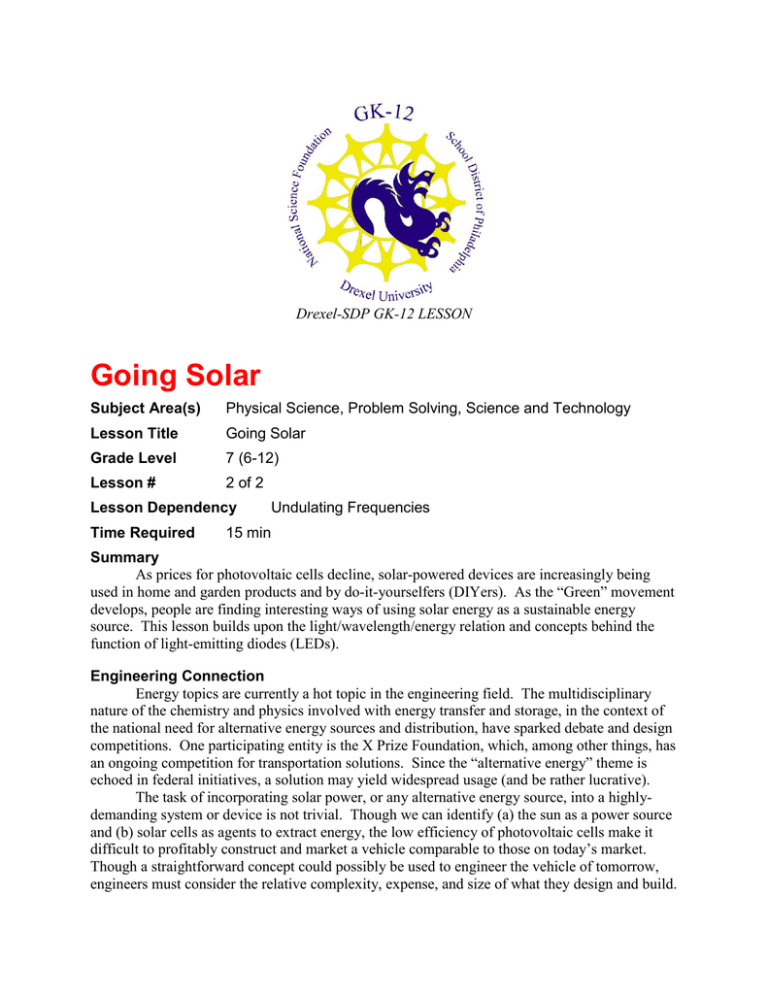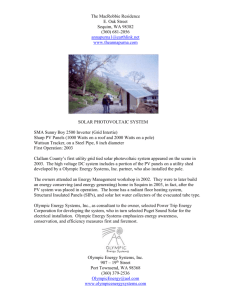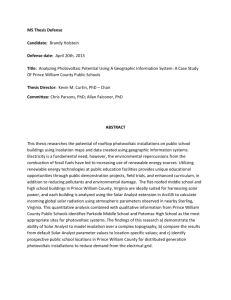Going Solar
advertisement

Drexel-SDP GK-12 LESSON Going Solar Subject Area(s) Physical Science, Problem Solving, Science and Technology Lesson Title Going Solar Grade Level 7 (6-12) Lesson # 2 of 2 Lesson Dependency Time Required Undulating Frequencies 15 min Summary As prices for photovoltaic cells decline, solar-powered devices are increasingly being used in home and garden products and by do-it-yourselfers (DIYers). As the “Green” movement develops, people are finding interesting ways of using solar energy as a sustainable energy source. This lesson builds upon the light/wavelength/energy relation and concepts behind the function of light-emitting diodes (LEDs). Engineering Connection Energy topics are currently a hot topic in the engineering field. The multidisciplinary nature of the chemistry and physics involved with energy transfer and storage, in the context of the national need for alternative energy sources and distribution, have sparked debate and design competitions. One participating entity is the X Prize Foundation, which, among other things, has an ongoing competition for transportation solutions. Since the “alternative energy” theme is echoed in federal initiatives, a solution may yield widespread usage (and be rather lucrative). The task of incorporating solar power, or any alternative energy source, into a highlydemanding system or device is not trivial. Though we can identify (a) the sun as a power source and (b) solar cells as agents to extract energy, the low efficiency of photovoltaic cells make it difficult to profitably construct and market a vehicle comparable to those on today’s market. Though a straightforward concept could possibly be used to engineer the vehicle of tomorrow, engineers must consider the relative complexity, expense, and size of what they design and build. Keywords solar, energy, voltage, photovoltaic Educational Standards PA Science: o 3.1.7 – Unifying themes o 3.2.7.B – Apply process knowledge to make and interpret observations Learning Objectives After this lesson, students should be able to: Identify the similar concept between photovoltaic cells and LEDs Describe the environment necessary to produce photovoltaic cells Hypothesize difficulties associated with using solar cells in applications with high energy demands Introduction / Motivation Recap last lesson and activity, Undulating Frequencies and Lit Up. In the previous lesson, we investigated how the voltage of LEDs varied with certain wavelengths (color), and therefore energy states. What if I told you that we can do that in reverse? And that you have definitely seen them, and possibly even used them? Let’s go back to the basics. An electrical potential (voltage) moves electrons between a defined energy state in a p-n junction, releasing that energy as a certain emitted wavelength, or light. Have you heard of a device that takes in light and outputs voltage? Solar cell. What is the power source of a solar cell? The sun. What is another name for solar cells, derived from Greek origin [that describes voltage: volt] [occurring due to light: photo] – photovoltaic. Solar cells are commonly called photovoltaic (PV) cells, and the energy states in p-n junctions of a photovoltaic cell are separated by energy gaps that can be excited by incident sunlight. The excited electrons then move through the p-n junction, starting a flow of electrons (voltage). Photovoltaic products, such as solar lamps (which commonly use LEDs!) are readily available at home improvement stores. Not only does the solar panel charge a battery, but it is also connected to a photocell (also available separately for incandescent lighting) that turns the light on when the light is low (night) and off during the daytime when there is sufficient ambient light. Because photovoltaic cells are made from silicon and require a clean-room production environment (similar to computer processors, see “How It’s Made” clip), a limited number can be produced at a time. In recent years, suppliers have found methods to profitably produce solar cell panels, but even though these panels have become less expensive, their components are cheaper and the energy efficiency is low. Nevertheless, hobbyists and do-it-yourselfers (DIYers) have experimented with solar cells and documented ways to inexpensively create items that function similarly to expensive retail brands. A search for self-charging laptop case can yield products for hundreds of dollars, though the materials and tools may only total a fraction of that. With regard to the demand for alternative energy sources, students are encouraged to construct something with solar cells, or at least monitor the output voltage from single and multiple photovoltaic panels. The results are tangible, but it takes a lot of solar panels to accumulate enough energy for, say, a car (see “Solar Car” video clip). 2 Vocabulary / Definitions Word Definition Photovoltaic A circuit element that produces voltage from incident light that excite cell electrons, raising their energy state to that of a p-n band gap and causing electrons to flow through the p-n junction The energy gap required for electrons to flow from one side of the junction to Band Gap the other. This energy is determined by the chemical composition of the junction. Light Emitting Diode (LED) A light emitting diode consists of a chemically-doped “p-n” junction that permits the flow of electrons at specified energy states. The diode illuminates at or above the energy state. Wavelength A wavelength is the distance between peaks (or troughs) on a waveform. Voltage The energy per unit charge, typically measured between two points. Also known as the electrical potential between two points. Lesson Closure With a multimeter, students should measure output voltage from solar panels in room conditions and outside in sunny weather conditions. Lesson Extension Activities A solar-powered-vehicle building activity can be used to complement this lesson. Additional Multimedia Support Lesson_GoingSolar.ppt, slides which introduce and illustrate homegrown and commercial uses of photovoltaic cells. Lesson_GoingSolar.zip, which contains the following files: How It_s Made – Solar Panels.mp4, a “How It’s Made” clip on solar panels, originally downloaded from http://www.youtube.com/watch?v=qYeynLy6pj8. Solar Powered Car Official contender for the Progressive Automotive X-Prize Part2_HD.mp4, a YouTube clip promoting an X Prize competition entrant who created a vehicle powered by solar energy alone. Originally downloaded from http://www.youtube.com/watch?v=eFGZH4nGoHI. Owner Drexel University GK-12 Program Contributors John C. Fitzpatrick, Mechanical Engineering and Mechanics, Drexel University Copyright Copyright 2010 Drexel University GK-12 Program. Reproduction permission is granted for nonprofit educational use. 3







